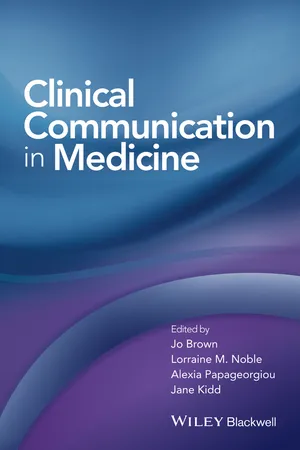
Clinical Communication in Medicine
- English
- ePUB (mobile friendly)
- Available on iOS & Android
Clinical Communication in Medicine
About this book
Highly Commended at the British Medical Association Book Awards 2016
Clinical Communication in Medicine brings together the theories, models and evidence that underpin effective healthcare communication in one accessible volume. Endorsed and developed by members of the UK Council of Clinical Communication in Undergraduate Medical Education, it traces the subject to its primary disciplinary origins, looking at how it is practised, taught and learned today, as well as considering future directions.
Focusing on three key areas – the doctor-patient relationship, core components of clinical communication, and effective teaching and assessment – Clinical Communication in Medicine enhances the understanding of effective communication. It links theory to teaching, so principles and practice are clearly understood.
Clinical Communication in Medicine is a new and definitive guide for professionals involved in the education of medical undergraduate students and postgraduate trainees, as well as experienced and junior clinicians, researchers, teachers, students, and policy makers.
Frequently asked questions
- Essential is ideal for learners and professionals who enjoy exploring a wide range of subjects. Access the Essential Library with 800,000+ trusted titles and best-sellers across business, personal growth, and the humanities. Includes unlimited reading time and Standard Read Aloud voice.
- Complete: Perfect for advanced learners and researchers needing full, unrestricted access. Unlock 1.4M+ books across hundreds of subjects, including academic and specialized titles. The Complete Plan also includes advanced features like Premium Read Aloud and Research Assistant.
Please note we cannot support devices running on iOS 13 and Android 7 or earlier. Learn more about using the app.
Information
CHAPTER 1
Introduction
- the doctor-patient relationship;
- key components of clinical communication; and
- effective teaching and assessment of clinical communication.
PART 1
The doctor-patient relationship
CHAPTER 2
Introduction to the Doctor–Patient Relationship
CHAPTER 3
History of the Doctor–Patient Relationship
From a trade to a profession
Table of contents
- Cover
- Title Page
- Table of Contents
- List of Contributors
- Foreword
- CHAPTER 1: Introduction
- PART 1: The doctor-patient relationship
- PART 2: Components of Communication
- PART 3: Learning, Teaching and Assessment
- PART 4: Afterword
- Index
- End User License Agreement